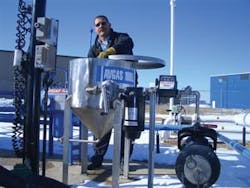Fixed base operators diligently take fuel samples each morning to provide evidence that the fuel they will be selling that day meets industry standards. And every day these good samples are thrown away into 55-gallon drums, slop or waste tanks. The shrewd operators (or so they think) burn these fuel samples in ground support equipment; but if the fuel is good by industry standard, why is it being thrown away or burnt in GSE equipment? Wasting quality fuel doesn’t make sense, which is why there is a movement towards the installation of fuel recovery units (FRUs) which process good jet-A and avgas samples into fuel that can be sold at full retail price, by recycling back to storage.
Fuel samples are taken from various sampling points located around the fuel farm and refuelers. The samples generally range from two to five gallons per sampling point, and the amount of sampling points vary from fuel farm to fuel farm. Samples are taken for both jet-A and avgas.
A real -world example of the amount of fuel ($$$) wasted at an FBO in Colorado went like this: its jet-A fuel samples were totaling 40 gallons a day, 365 days a year, which totaled 14,600 gallons of clean dry jet-A that was thrown away annually. To add insult to injury, the FBO has to pay to have this “waste” hauled off the airport and disposed of properly.
The argument regarding using the jet fuel in mobile fuel trucks, ground power units, and diesel tugs is a dangerous gamble. This can cause serious engine problems for vehicles not designed for this type of fuel, or not properly blended with lubricating additives required for most diesel engine injector pumps and for newer engines designed for ultra low sulfur diesel(ULSD).
Conservation of avgas is becoming critical because of the decreased amount of oil companies who are willing to store the 100LL fuel because of the lead content and the extreme expense of transporting it from much greater distances than ten years ago. Like jet fuel, burning avgas in GSE equipment isn’t recommended because not all gasoline engine fuel system components are compatible with this type of fuel. This practice can cause engine fires which destroy valuable pieces of equipment. The aforementioned Colorado operator figured out that they were wasting 1,889 gallons of avgas each year by not using a fuel recovery unit.
Limiting exposure
Another benefit of the fuel recovery unit is the safety benefit when defueling the bulk plant filters and mobile truck filter vessels. The use of the FRU eliminates environmental exposure by curtailing 55-gallon drums sitting around the facility and eliminating risk to maintenance personnel by having closed loop fuel equipment drain downs alleviating fire or fuel spills in the shop drains.
The fuel trucks can defuel filter vessels before they enter service shops for preventative maintenance, breaking the old unsafe habit of pulling the truck in the shop and performing the filter drain down inside and dealing with open containers of fuel. Most new fuel trucks and bulk storage plants have filter vessels that can hold from 60 to 150 gallons of product that has to be drained down once a year for annual filter changes. It is good business to reclaim the fuel back to storage and sell it at full retail price, when properly processed.
FRUs increase the efficiency in plant operators daily quality control processing of fuel samples. There is a reduction in the amount of paperwork generated by tracking and logging fuel samples being thrown away and stored in slop and waste tanks.
There are a number of FRUs on the market ranging from good to bad designs. Like all other products, one must do their homework. For the company that is entertaining the purchase of this type of product, there are a number of factors to consider when selecting the right type of FRU. Does the fuel supplier have specific requirements for this type of equipment? Will the unit require electrical power, remote samples, FSII, seasonal spikes in business, etc.?
FRUs come in many different sizes ranging from small 15-gallon economy units to larger 200-gallon units; however, most manufacturers will custom build any size unit. A typical cost for an all stainless steel model like the one pictured with the filter and meter can cost $4,400 to $16,000 for the larger 200-gallon stainless steel unit with electric pump, motor, heater, sight tube, and defuel option. Installation costs can only be determined after review of the fuel facility by a competent aviation fuel mechanical contractor. In most cases, this can be done via email and digital pictures.
Depending on how simple or complex the fuel facility, installation time can range from one day per unit to several weeks for more complex systems with multiple tanks.
The typical payout averages from six months to a year. Whether the economy is a bull or a bear, this type of equipment gives FBOs a new knob they can twist to add dollars to the bottom line.
About the Author
Bob Thompson is president of TWS Aviation Fuel Systems, LLC, a specialty mechanical contractor and consulting firm serving the commercial and general aviation industry. He has been involved in the midstream and downstream petroleum business since 1979, from natural gas processing plants, natural gas distribution pipelines, major oil company storage terminals, and regional to international airport storage terminals.
Reach him at (303) 768-8540 or [email protected].





